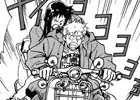Route 20
| Genre: Drama | ||
| Length: 1 Volume | ||
| Allegiance: Kadokawa Shoten | ||
| Mangaka: Sadamoto Yoshiyuki | ||
| Vintage: 1993 | ||
| Intelligence Agency Report by: Djudge | ||
| In the future, the level of pollution has forced humanity to live in domed shelters that shield them from the now toxic outside air. Akagi Utsuo is a product of this cloistered society and let’s just say he isn’t a model citizen. Plagued by both a nagging family and a lack of any real friends, Utsuo picks apart his days as a loner with nowhere to turn to besides a motorbike gang. Isn’t there anything around there that can break this young man’s monotonous life? | ||
|
|
||
| Research Agent Report by: Djudge | ||
| Plot Characters Impact Visual |
6.50 6.50 6.75 8.75 |
|
| Overall | 7.00 | |
| (not an average) | ||
| Sadamoto Yoshiyuki isn’t really known so much for his work as a mangaka as he is a character designer for big-name productions such as Neon Genesis Evangelion and .hack//SIGN. However, from time to time, he does manage to exhibit his storytelling abilities by publishing a one-shot or even the occasional one tankouban title. Route 20 is part of the latter category and while it’s not exactly the best entry into the “coming-of-age” manga, this title’s insightful ending can win readers over… or utterly turn some of them off.
Being a fan of Sadamoto’s work, I can pretty much say that going into R20 I felt fairly confident in my eyes having a great time passing over the artwork. Thankfully, I was correct in this assumption and ended up getting a kick out of Sadamoto’s vision of a completely mechanized urban setting. Everything from the vehicles to the architecture was a treat to look at and it is fairly likely that the designs for these objects were probably deliberated as much, if not more than the actual themselves. Another highlight that should also be mentioned is the level of detail that takes up each panel, particularly in the final chapter of Utsuo’s story. The attention paid to various aspects of Utsuo’s surroundings is quite heavy and really adds more to the visual atmosphere presented in the panels. Even though the reader probably would’ve been able to make it through the manga without this additional work, it remains as a plus for those who like their characters immersed in a picturesque and vivid environment. All said and done, it goes without saying that clearly R20’s biggest asset is the fact that Sadamoto was its illustrator. Unfortunately, it becomes clear after finishing the manga that Sadamoto didn’t do as a good a job with R20’s story as he did with its visuals. To be honest, the whole idea of Utsuo playing the loner in a biker gang was a premise that really didn’t appeal that much to me. Most of the other characters were also bargain-bin quality, mostly recycled personalities that I’ve seen in other stories that were redrawn in order to fit better in the series. It wasn’t until about halfway through the story, after the whole motorbike ordeal was downplayed some, that I finally began to connect more and more with the lead character. Utsuo’s exploration into first love and heartrending betrayal were genuine and his perspective on life could really make a connection with some readers. The protagonist’s eventual escape from obscurity and ridicule culminates in a chapter filled with a theme of reflection and the attainment of an inner peace. However, while Sadamoto did deliver a conclusion infused with what I consider a positive message, the reader’s journey through the musings of life with Utsuo is severed prematurely. Believe me, if you ever wanted to watch a main character see something through the end, you’ll be disappointed at the point in time when we part ways with Utsuo. Route 20 sure is a great piece of artwork to look through, and it does offer a passable tale to kill off some extra time. While you really can’t call this title a classic by any means it still manages to retain one special trait in its warm ending. Utsuo wasn’t a famous manga character after Route 20 was published, but I have a feeling that you will not forget him any time soon after you finish this title.
|
||




